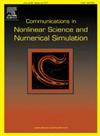Local entropy and nonextensivity of networks ensemble
IF 3.8
2区 数学
Q1 MATHEMATICS, APPLIED
Communications in Nonlinear Science and Numerical Simulation
Pub Date : 2025-09-26
DOI:10.1016/j.cnsns.2025.109369
引用次数: 0
Abstract
Network ensemble is a physical model proposed to describe complex networks under different constraints with heterogeneously interacting units. It is generally believed that the complexity of such systems arises from these heterogeneous interactions, which are nonextensive and nonadditive. In other words, exploring how nonextensivity is generated in network ensembles is significant for understanding how complexity emerges in networked complex systems. In this work, based on the concept of local entropy in network ensembles and the detection of nonlinear increases in local entropy of network ensembles represented by matrices with local constraints, we find that network ensembles are nonextensive; that is, nonextensivity generally exists in network ensembles. Through detailed calculation of the local entropy for newly added nodes, we also find that the freedom of nodes to connect with each other causes the appearance of nonextensivity in network ensembles. In other words, the complexity in complex networks may emerge from free local interactions within the network, which is fundamentally different from the constrained local interactions in the Ising model. These results show that local entropy is a powerful framework for studying nonextensivity in network ensembles, and is also a significant method for understanding complexity in networked complex systems.
网络集成的局部熵和非扩展性
网络集成是一种描述不同约束条件下具有异构相互作用单元的复杂网络的物理模型。一般认为,这种系统的复杂性源于这些非扩展和非加性的异质相互作用。换句话说,探索非扩展性如何在网络集成中产生对于理解复杂性如何在网络复杂系统中出现是非常重要的。本文基于网络集成中的局部熵的概念,通过检测具有局部约束的矩阵表示的网络集成的局部熵的非线性增长,我们发现网络集成是非扩展的;也就是说,非扩张性一般存在于网络集成中。通过对新增节点的局部熵的详细计算,我们还发现,节点之间的自由连接导致网络集成出现非延展性。换句话说,复杂网络中的复杂性可能来自于网络内部的自由局部相互作用,这与Ising模型中受约束的局部相互作用有着根本的不同。这些结果表明,局部熵是研究网络集成非延展性的有力框架,也是理解网络复杂系统复杂性的重要方法。
本文章由计算机程序翻译,如有差异,请以英文原文为准。
求助全文
约1分钟内获得全文
求助全文
来源期刊

Communications in Nonlinear Science and Numerical Simulation
MATHEMATICS, APPLIED-MATHEMATICS, INTERDISCIPLINARY APPLICATIONS
CiteScore
6.80
自引率
7.70%
发文量
378
审稿时长
78 days
期刊介绍:
The journal publishes original research findings on experimental observation, mathematical modeling, theoretical analysis and numerical simulation, for more accurate description, better prediction or novel application, of nonlinear phenomena in science and engineering. It offers a venue for researchers to make rapid exchange of ideas and techniques in nonlinear science and complexity.
The submission of manuscripts with cross-disciplinary approaches in nonlinear science and complexity is particularly encouraged.
Topics of interest:
Nonlinear differential or delay equations, Lie group analysis and asymptotic methods, Discontinuous systems, Fractals, Fractional calculus and dynamics, Nonlinear effects in quantum mechanics, Nonlinear stochastic processes, Experimental nonlinear science, Time-series and signal analysis, Computational methods and simulations in nonlinear science and engineering, Control of dynamical systems, Synchronization, Lyapunov analysis, High-dimensional chaos and turbulence, Chaos in Hamiltonian systems, Integrable systems and solitons, Collective behavior in many-body systems, Biological physics and networks, Nonlinear mechanical systems, Complex systems and complexity.
No length limitation for contributions is set, but only concisely written manuscripts are published. Brief papers are published on the basis of Rapid Communications. Discussions of previously published papers are welcome.
 求助内容:
求助内容: 应助结果提醒方式:
应助结果提醒方式:


